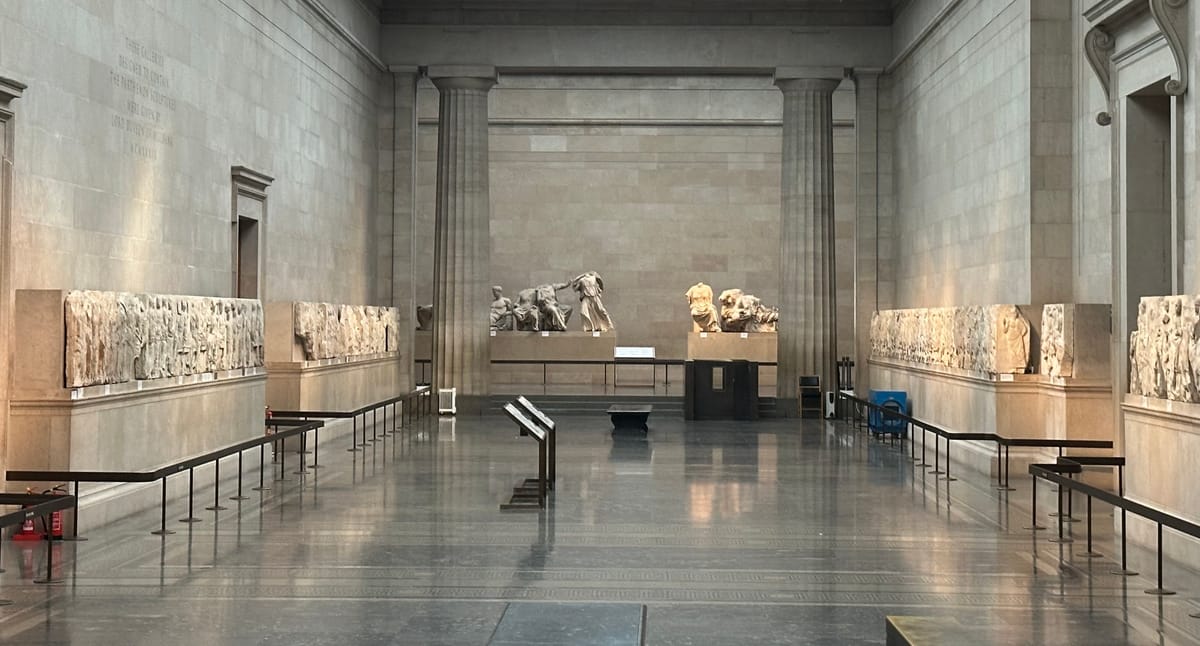A Legal Certainty: They're Our Marbles
The Parthenon Marbles, acquired by Lord Elgin in the early 19th century, must be retained in Britain. This piece considers their preservation, the ambiguity of their original acquisition, the fragility of modern restitution frameworks, and the recurrent economic instability in Greece.

When addressing the controversy surrounding the Parthenon Marbles’ removal from the Acropolis by Thomas Bruce (1766–1841), Seventh Earl of Elgin, one must address the controversy both at its time and retrospectively. First, the nature of the controversy at the time of their removal in 1801 must be considered. The removal, then, was less contentious than the remover.
Bruce was serving as ambassador to the Ottoman Empire at the time. The chief concern was a possible betrayal of his stately duties. He had secured a royal mandate from the Ottoman Empire permitting the removal of “any sculptures or inscriptions which do not interfere with the works or walls” of the Parthenon. However, it must be noted that the original firman does not survive. Only an Italian translation remains, which has led to continued debates over the exact scope of what was permitted. Nevertheless, Parliament in 1816 deemed Bruce’s actions legally justified when it approved the British Museum's purchase of the marbles (Times Digital Archive, 1816).
Notable public figures such as Lord Byron (1788–1824) suggested the removal commodified the statues as objects of trade, a critique concerned with the function of art rather than the legality of Bruce’s actions. Yet there was little doubt in the minds of most MPs about the intrinsic value of the marbles as artefacts when discussions began regarding their purchase. Given the sculptures had already been removed, shipped, and brought to the British Isles, Chancellor of the Exchequer, Rt. Hon. George Tierney (1761–1830), commented “retaining possession of this most valuable collection…would be preferable” over the possibility they might be sold separately and scattered across the country.
Tierney’s stance suggests the purchase was a matter of pragmatism rather than a premeditated desire to rob Greece of its cultural patrimony, as is often the story in retrospect. His comments also imply an understanding forcibly fragmented monuments, collected as souvenirs, lose much of their historical and aesthetic value. The significance of the statues would only be further debased if sold into private ownership. Although their meaning had already been diluted by removal from context, approximately 2250 years of weathering and vast cultural changes, it was not an option to undo these factors. Yet, retaining them as a collection would be less harmful than separation.
The case for the acquisition of the marbles came the same year as Napoleon Bonaparte’s (1769–1821) defeat at Trafalgar. Revolutionary France had routinely plundered art to mirror the actions of the Roman republic. These artefacts were forcibly restored to Rome following Napoleon's defeat. There is a case to be made hypocrisy is at work in the British Parliament. However, to suggest this would ignore the flagrantly aggressive purposes for which Napoleon plundered Rome. His loot was exhibited in the Musée Napoléon as triumphal symbols of conquest.
This stands in stark contrast to Bruce’s self-proclaimed protective motives. Not least, Bruce’s removals began in 1801, a time at which the marbles too were at risk of becoming plunder at the hands of Napoleon’s agents. The practice of removing statues and decorative reliefs was commonplace in Athens prior to Bruce’s acquisition. Turkish soldiers occupying Greece had routinely sold fragments of antique art to Europeans as keepsakes. In effect, this was antiquarian-caused vandalism.
While this lends credence to Bruce’s claims to have rescued the marbles, it also indicates a growing desire for the antique among the middle-class European tourist. Further evidence of the Ottoman disregard for heritage lies in their use of the Parthenon as a gunpowder store, a decision that led to a devastating explosion in 1687 when the building was shelled by Venetian forces.
Imperial powers desired their art and architecture to reflect their strategic reach and values, but perhaps more importantly, veneration of the antique had steadily grown in popularity within the British middle classes throughout the 18th century. It follows public opinion was favourable to the removal. The term “Elgin Marbles” was in circulation 16 years prior to their purchase by Act of Parliament in 1816. The acquisition satisfied both imperial hubris and the 19th-century museum-going dilettante. The British Empire was locating its cultural origins in Greece.
Neoclassicism was still the dominant British pseudo-national style and public discourse drew heavily on the trope of London as a “New Athens,” all of which aided Bruce’s cause. In addition to the naturally occurring shift in public taste, Bruce operated a campaign of his own to persuade the public of the merits of retaining the marbles. In one notable example, Robert Gregson (1778–1824), an English prize-fighting champion, was displayed naked alongside the marbles. The desired effect being that if the naked celebrities looked just like the mounted Greek warriors, then Britons might gain confirmation that they were the embodied legacy of ancient Athens.
Such casual, public interest in ancient Greece, alongside a deficit in art historical understanding of ancient sculpture, had adverse effects on the artefacts themselves. In 1937, under Sir Joseph Duveen’s (1869–1939) encouragement, the marbles were cleaned and bleached. This was done under the misconception that the marbles were originally white. The cleaning caused irreparable damage and stands as an example of British identification with a fictionalised past.
This was an unwitting identification with the doctrines of Johann Joachim Winckelmann, not the Athens of 400 BC that produced the marbles. Misconceptions such as this are the adverse effect of Bruce’s efforts to assimilate the marbles as icons of Britain as opposed to ancient Greece. Yet, this damage seems a small price to pay compared to their potential sale or destruction at the hands of Napoleon or the Ottomans.
This said, the controversy surrounding the marbles today is fixated on whether these artefacts were the occupying Ottomans’ to give. Accordingly, Greece formally requested that the United Kingdom return the Elgin Marbles in the early 1980s. Notably, such calls have historically coincided with periods of economic hardship in Greece, which has experienced recurrent recessions in the 21st century.
The 1954 Hague Convention for the Protection of Cultural Property in the Event of Armed Conflict remains the only agreement protecting works of art in times of conflict (Hague Convention). However, it fails to offer a policy for their return. The 1970 UNESCO convention prohibiting the illicit import, export and transfer of ownership of cultural property offers a justification for the return of the marbles (note 27). Yet, it fails to explicitly address who owns such works of cultural property. The conventions apply to modern disputes, not to events predating their ratification.
Moreover, their return to their original context at the Parthenon poses new problems. Concerns have been raised about Greece's ability to safeguard the marbles given the country’s economic situation. Claims militant groups such as Islamic State pose a threat through Greece are largely unsubstantiated, but concerns about infrastructure and security persist.
In summary, the Parthenon Marbles' continued presence in Britain is not merely a relic of imperial acquisition but a consequence of complex historical, cultural and legal circumstances. While the debate rightly engages with questions of origin and identity, arguments for retention rest on their continued preservation, public accessibility and contextualisation within a global heritage institution.
The Duty of Trustees
The debate over the Elgin Marbles cannot be separated from the legal role of trusteeship. In the United Kingdom, a trust is a legal arrangement in which one party (the trustee) holds and manages property for the benefit of another (the beneficiary). Trustees are legally obliged to act in accordance with the trust’s terms, prioritising the interests of beneficiaries and the preservation of the trust’s assets. The British Museum operates under such a public trust framework, governed by the British Museum Act 1963. Under this legislation, trustees are appointed to hold the collection on behalf of the nation, with a statutory duty to preserve and maintain the collection for the public benefit.
Trustees of the British Museum do not own the artefacts personally but are custodians on behalf of the public. Their legal obligations include ensuring that objects are conserved, made accessible, and interpreted in line with the Museum’s founding principles. These principles do not include the restitution of objects for symbolic or diplomatic purposes unless explicitly allowed by law, which the 1963 Act currently prohibits in the case of the Parthenon Marbles.
There is growing concern that heritage institutions are drifting from this responsibility. The National Trust, for example, has been criticised for abandoning its founding principle of stewardship for the nation in favour of ideological reinterpretation. Restore Trust, a campaign group formed in response to these shifts, contends the organisation has compromised its commitment to neutrality and long-term preservation. The group points to changes in exhibition curation, governance, and priorities as evidence of an erosion of the trust’s founding mission.
The British Museum must not follow this path. The marbles are not mere symbols of dispute but fragments of world heritage entrusted to the care of Britain. They are not to be handed over hastily or unilaterally but conserved, studied and made accessible to the global public under the lawful stewardship of its trustees.




